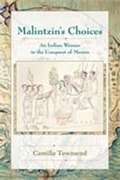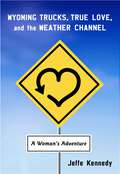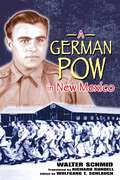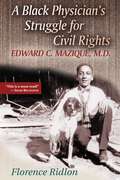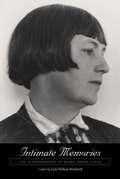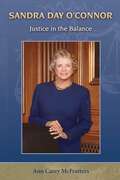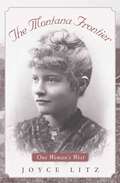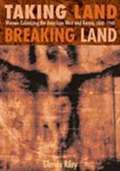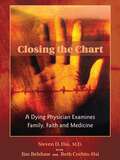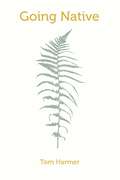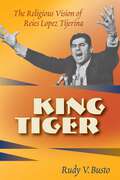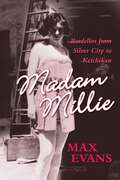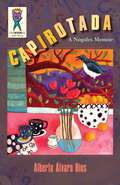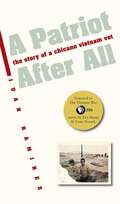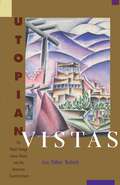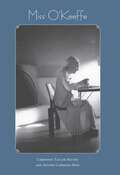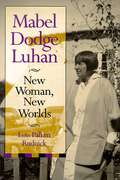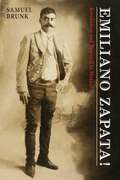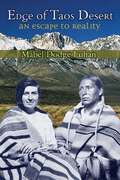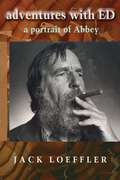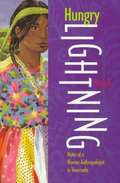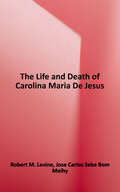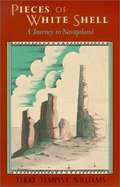- Table View
- List View
Malintzin's Choices: An Indian Woman in the Conquest of Mexico (Dialogos Series)
by Camilla TownsendIn this study of Malintzin's life, Camilla Townsend rejects all the previous myths and tries to restore dignity to the profoundly human men and women who lived and died in those days. Drawing on Spanish and Aztec language sources, she breathes new life into an old tale, and offers insights into the major issues of conquest and colonization, including technology and violence, resistance and accommodation, gender and power.
Wyoming Trucks, True Love, and the Weather Channel: A Woman's Adventure
by Jeffe KennedyThese essays explore the challenges Jeffe Kennedy has faced as a woman, a Westerner, a father-less daughter, a stepmother, a biologist, and a girl with hair of no specific color. From the book's opening in a cornfield, where Kennedy is searching for the twenty-five-year-old site of the plane crash that killed her father, she seems to be in constant motion. She is the feminist adolescent, ashamed to win a prize in home economics who learns to take joy in her pastry skills. She is the scientist struggling with mortality, the liberal learning to shoot a gun.With cheeky wisdom, Jeffe Kennedy explores the extraordinary moments that transform ordinary lives. No revelation--from the meaning of the death of a parent to being a blonde--is too big or small for this Colorado-born biologist to dissect. Her insights tell us a lot about the way lives enhanced by real convictions are formed.--Vicki Lindner, author of Outlaw Games[Kennedy] writes vividly and with great clarity. Her sensitivity and empathy for other people enhances an unusually authentic ability to establish three-dimensional characterization.--Lee Gutkind, editor, Creative Nonfiction
A German POW in New Mexico (Historical Society of New Mexico Publication Series)
by Walter SchmidWalter Schmid, a member of Rommel's Afrika Korps, was one of hundreds of thousands of POWs interned in the United States during World War II. Drafted into the German army at twenty, he had fought for only five months when captured in Tunisia in May 1943. Schmid was sent first to POW camps in Oklahoma (Gruber, Bixby, and McAlester) and was soon transferred to New Mexico in July 1944.Walter Schmid worked in southern New Mexico's Mesilla Valley picking cotton and harvesting melons alongside Mexican-American laborers. He recalls playing trumpet in the camp orchestra and watching Sunday soccer games between the teams of rival POW camps. Based on his diary and the letters he sent home to his German girlfriend, whom he later married, Schmid's memoir was published in Germany in 2000. This abbreviated English translation begins with his capture in North Africa and his voyage to the United States and ends with his work experience in England, where he was transferred after almost three years of captivity in the United States, and his return to Germany in 1947.
A Black Physician's Struggle for Civil Rights: Edward C. Mazique, M.D.
by Florence RidlonThis powerful biography traces the career of an African American physician and civil rights advocate, Edward Craig Mazique (1911–1987), from the poverty and discrimination of Natchez, Mississippi, to his status as a prominent physician in Washington, DC. This moving story of one man&’s accomplishments, in spite of many opposing forces, is also a chapter in the struggle of African Americans to achieve equality in the twentieth century.At a time when black people were being denied entry into the American Medical Association and were not permitted to join the staffs of most hospitals, Dr. Mazique was the president of the Medico-Chirurgical Society and the National Medical Association. Dr. Mazique worked closely with Martin Luther King Jr., Presidents John F. Kennedy and Lyndon B. Johnson, and black physicians to expand the availability of health care. Much of this story is in Dr. Mazique&’s own words, taken from interviews with the author. What emerges from this biography is a picture of an exceptional but very human man who, despite discrimination and repression, excelled beyond all expectations.
Intimate Memories: The Autobiography of Mabel Dodge Luhan
by Mabel Dodge LuhanMabel Dodge Luhan&’s Intimate Memories offers the brilliantly edited memoirs of one woman&’s rebellion against &“the whole ghastly social structure&” under which the United States had been buried since the Victorian era. Luhan fled the Gilded Age prison of the upper classes to lead a life of notoriety among Europe and America&’s leading artists, writers, and social visionaries—among them D. H. Lawrence, Gertrude Stein, and John Reed.Intimate Memories details Luhan&’s assemblage of a series of utopian domains aimed at curing the malaise of the modern age and shows Luhan not just as a visionary hostess but as a talented and important writer.
Sandra Day O'Connor: Justice in the Balance (Women's Biography Series)
by Ann Carey McFeattersOn July 1, 1981, President Ronald Reagan interviewed Sandra Day O'Connor as a candidate for the United States Supreme Court. A few days later, he called her. Sandra, I'd like to announce your nomination to the Court tomorrow. Is that all right with you? Scared and wondering if this was a mistake, the little-known judge from Arizona was on her way to becoming the first woman justice and one of the most powerful women in the nation. Born in El Paso, Texas, O'Connor grew up on the Lazy B, a cattle ranch that spanned the Arizona-New Mexico border. There she learned lifelong lessons about self-reliance, hard work, and the joy of the outdoors. Ann Carey McFeatters sketches O'Connor's formative years there and at Stanford University and her inability to find a job--law firms had no interest in hiring a woman lawyer. McFeatters writes about how O'Connor juggled marriage, a career in law and politics, three sons, breast cancer, and the demands of fame.In this second volume in the Women's Biography Series, we learn how O'Connor became the Court's most important vote on such issues as abortion, affirmative action, the death penalty, the role of religion in society, and the election of a president, decisions that shaped a generation of Americans.
The Montana Frontier: One Woman's West
by Joyce LitzThis true story of a Victorian-era young woman who follows her husband to a small town with the improbable name of Gilt Edge, Montana, will remind readers of Wallace Stegner's Angle of Repose, the classic novel of a woman's life in the Mountain West. As a young girl, Lillian Weston, the author's grandmother, aspired to be a concert pianist. However, as a young woman in turn-of-the-century New York, she became a newspaper columnist. Her marriage to Frank Hazen took her west in 1899, ending her career as a newspaperwoman. She turned her writing skills to journals, diaries, stories, and poems, which traced her family's life on a frontier that was no longer unspoiled. The Hazens endured brutal winters and dry summers and endeavored to raise cattle and chickens by trial and error. Lillian was an assiduous diarist who included details of her turbulent marriage challenged by Frank's bad business deals. The details of birth control and child rearing, gambling and prostitution, education and health care are all part of this story, offering glimpses into everyday life that often go unreported in the larger story of western expansion.
Taking Land, Breaking Land: Women Colonizing the American West and Kenya, 1840-1940
by Glenda RileyIn spite of considerable similarities, the American West and Kenya have rarely been compared or contrasted by historians, until now. This book examines the lives of women colonists on the American and Kenyan frontiers to demonstrate the importance of gender and race in shaping women's frontier experience. Although the West and Kenya are half a world apart, have natives of different races, and developed at different periods, the lives of women colonists show remarkable parallels. On both frontiers, white women were active agents of colonial conquest. They believed in the necessity of imposing their culture upon native peoples to bring about 'civilisation'. In turn, the colonised responded by resisting, which meant that women of colour seldom allied with white women. Riley's discussion of the historical experiences of these two frontiers addresses such crucial issues as women's roles in the continuation of colonisation in the US West as opposed to their roles in its collapse in Kenya. Although she uses post-modern theoretical concepts of self and other, of resistance and adaptation, her writing will appeal to a broad audience of students, scholars, and general readers.
Closing the Chart: A Dying Physician Examines Family, Faith, and Medicine
by Steven D. HsiDr. Steven D. Hsi, a family physician and father of two young sons, was diagnosed in 1995 with a rare coronary disease that caused his death five years later at the age of forty-four. Throughout his ordeals as a patient, including three open-heart surgeries, Dr. Hsi's outlook on the teaching and practice of medicine changed. In 1997 he began a journal intended for publication after his death. Written with the assistance of newspaper columnist Jim Belshaw and completed posthumously by Hsi's widow, Beth Corbin-Hsi, Dr. Hsi's writings urge his colleagues to become healers, to look at their patients as human beings with spiritual as well as physical lives.Every patient should read it, if only to be made aware that they are not alone with their thoughts. Every spouse of a patient should read it. . . . Every medical student and physician should read it to learn that the biology of the disease is really just a small part of the illness.--John Saiki, M.D., Medical Oncology, University of New MexicoDr. Steven Hsi asks his fellow doctors to be more than physicians. He asks them to be healers. He says that when he thinks of healers, he sees traditional medicine men, people who are integral parts of their communities. They are in touch physically and spiritually with the people they serve.--Tony HillermanClosing the Chart is built on the personal journals and experiences of Steven D. Hsi, M.D., as he travels on an intense 5-year journey from an assumption of health, professional success, and family stability to his progressive illness and eventual death. . . . Closing the Chart is both an engaging, page-turning read and a story told with so little artifice that you cannot close the cover unchanged.--Kenneth Jacobson, executive director, American Holistic Medical Association, Explore &“There are lessons on every page, lessons to make us better caregivers, more discerning patients, and better advocates for family members and friends who are sick. . . . Every reader will take away different lessons from this book based on his or her role, age, and experience. This would be an ideal book for group study by medical and nursing students with some senior physicians, patients, and family members. What a great learning experience for all participants! . . . I exhort you to pick up and read this humble story. Nothing I have encountered in the medical narrative genre has been more worthy of my time.&” —David J. Elpern, M.D, Psychiatric Services
Going Native
by Tom HarmerIn a spiritual autobiography shaped by years of living with a band of Salish Indian people after the Vietnam War, Tom Harmer shares his hard-won knowledge of their world and the nature spirits that govern it. Leaving behind college, military service, and years of living off the land as he drifted aimlessly and smuggled draft dodgers and deserters into Canada, Harmer came to the isolated Okanogan region of Washington state in the company of an Indian man hitchhiking home after Wounded Knee. Harmer was desperate to make something of his life. He settled down for nearly ten years close to his Indian neighbors, adopted their view of the world, and participated in their traditional sweatlodge and spirit contact practices. From his first sight of Chopaka, a mountain sacred to the Okanogan people, Harmer felt at home in this place. He formed close relationships with members of the Okanogan band living on allotments amidst white ranches and orchards, finding work as they did, feeding cattle, irrigating alfalfa, picking apples, and eventually becoming an outreach worker for a rural social services agency. Gradually absorbing the language, traditions, and practical spirit lore as one of the family, he was guided by an elderly uncle through arduous purification rites and fasts to the realization that his life had been influenced and enhanced by a shumíx, or spirit partner, acquired in childhood.
King Tiger: The Religious Vision of Reies Lípez Tijerina
by Rudy V. BustoRight now we look like a cricket. What is a cricket? King of the Insects; a little, tiny animal. All the cricket can do is [say] 'cricket, cricket, cricket.' Just a noise, that's all. But you know, if that cricket gets in the ear of the lion and scratches inside, there is nothing the lion can do. There is nothing; there is no way the lion can use his claws and jaws to destroy the cricket. The more the lion scratches himself the deeper the cricket goes. . . .--Reies López Tijerina, 1971Throughout his career in New Mexican land grant politics, Reies Tijerina frequently used this fable to inspire persistence in the face of impossible odds. As the leader of a grassroots Hispano land rights organization, the Alianza Federal de Mercedes Reales (The Federal Alliance of Land Grants), Tijerina has made an indelible imprint on New Mexico's Hispano culture. King Tiger details Tijerina's life and efforts--those real, rumored, and mythologized--in the first systematic study of the origin of his political ideas. Rudy Busto shows how one of Tijerina's particularly powerful mystical visions led him to northern New Mexico to fight to restore land to those who lost it during various nineteenth-century land grant title conflicts. More than three decades after the infamous Tierra Amarilla County courthouse raid, Tijerina remains an important touchstone for all New Mexicans. In his life and activism are found the interdependent issues of land, water, language, economic development, sovereignty, political power, and rights to cultural formation in the Southwest.
Madam Millie: Bordellos from Silver City to Ketchikan
by Max EvansMildred Clark Cusey was a whore, a madam, an entrepreneur, and above all, a survivor. The story of Silver City Millie, as she referred to herself, is the story of one woman's personal tragedies and triumphs as an orphan, a Harvey Girl waitress on the Santa Fe railroad, a prostitute with innumerable paramours, and a highly successful bordello businesswoman. Millie broke the mold in so many ways, and yet her life's story of survival was not unlike that of thousands of women who went West only to find that their most valuable assets were their physical beauty and their personality. Petite at five feet tall with piercing blue eyes, Millie captured men's attention by her very essence and her unmistakable joie de vivre.Born to Italian immigrant parents near Kansas City, she and her sister were orphaned early and separated from each other. Millie learned hard lessons on the streets, but she never gave up and she vowed to protect and support her ailing older sister. Caught in a domestic squabble in her foster home, Millie wound up in juvenile court with Harry Truman as her judge. This would be only the first of many brushes in her life with prominent politicians.When physicians diagnosed her sister with tuberculosis and recommended she move West to a Catholic home in Deming, New Mexico, Millie moved with her. Expenses ran high and after a brief stint waiting tables as a Harvey Girl, Millie found that her meager tips could easily be augmented by turning tricks. Thus, out of financial need and devotion to her sister, Mildred Cusey turned to a life of prostitution and a career at which she soon excelled and became both rich and famous.
I Married a Soldier
by Lydia Spencer LaneLydia Spencer Lane's account of her life as a young army bride on the early southwestern frontier is both invaluable history and delightful commentary. As an officer's wife, Lane left her home in Pennsylvania in 1854 to accompany her new husband to his first post in the West--the encampment at Fort Inge, Texas, then in the midst of a yellow-fever epidemic. For the next sixteen years, Lane crossed the Great Plains by wagon seven times, traveled nearly 8,000 miles, raised three children, and became accustomed to tours of duty that required the family to move at least every six months to a different set of military forts, frontier garrisons, and trailside bivouacs across New Mexico and Texas.First published in 1893 and unavailable for nearly a decade, Lane's narrative manifests a dry wit that lends humor to events that range from the uncomfortable to the terrifying. Through her eyes we see the close-knit social life of an army post, the western frontier's divided response to the American Civil War (including the Confederate invasion of the Mesilla Valley), and the cultures and peoples of the West. As Darlis Miller makes clear in her Introduction, Lane's courage, her sense of humor, her powers of observation, and her obvious love for the western landscape make her an unforgettable narrator, a valuable historian, and a bold exemplar of strength under pressure.
Capirotada: A Nogales Memoir
by Alberto Alvaro RíosCapirotada, Mexican bread pudding, is a mysterious mixture of prunes, peanuts, white bread, raisins, milk, quesadilla cheese, butter, cinnamon and cloves, Old World sugar--all this, writes Alberto Rios, and things people will not tell you.Like its Mexican namesake, this memoir is a rich melange, stirring together Rios's memories of family, neighbors, friends, and secrets from his youth in the two Nogaleses--in Arizona and through the open gate into Mexico. The vignettes in this memoir are not loud or fast. Yet like all of Rios's writing they are singular. Here is the story about a rickety magician, his chicken, and a group of little boys, but who plays a trick on whom? The story about the flying dancers and mortality. About going to the dentist in Mexico because it is cheaper, and maybe dangerous. About a British woman who sets out on a ship for America with the faith her Mexican GI will be waiting for her in Salt Lake City. And about the grown son who looks at his father and understands how he must ovide for his own boy.This book's uncommon offering is how it stops to address the quiet, the overlooked, the every day side of growing up. Capirotada is not about prison, or famous heroes. It is instead about the middle, which is often the most interesting place to find news.Capirotada was selected as the 2009 ONEBOOKAZ by the Arizona State Library, Archives and Public Records.
A Patriot After All: The Story of a Chicano Vietnam Vet
by Juan RamirezJuan Ramirez always believed he would die in Vietnam. As a teenager growing up in the San Francisco area in the early 1960s, Nam was there, just over the horizon, like the distant thump of artillery. His father and uncles had served in World War II, another uncle in Korea. Numerous cousins had enlisted. At nineteen, Ramirez decided to embrace the war. In 1968, the year of the Tet offensive, Ramirez joined the U.S. marines.Two bloody tours later, Ramirez survived, but at immense cost. Twice wounded, undesirably discharged, and plagued by survivor's guilt, Ramirez surveys the toll of Vietnam on flesh and spirit in this captivating memoir.Ramirez tells his story in a voice not often heard from the war, that of a Chicano soldier. By tracing his roots, and exploring the cultural pressures and social demons that weighed on his family and community, Ramirez offers an unflinching look at the fall and redemption of one Mexican American veteran.Ramirez has given us a rather unique and clear-eyed view inside the life and times and thoughts of a young Chicano who joins the marines and goes to Vietnam to find his destiny. . . . Fascinating reading.--Joseph L. Galloway, author of We Were Soldiers Once . . . And Young.
Utopian Vistas: The Mabel Dodge Luhan House and the American Counterculture
by Lois Palken RudnickWinner of the 1996 Gaspar Perez de Villegra Award from the Historical Society of New MexicoMabel Dodge Luhan, hostess and visionary, made Taos, New Mexico, a center for artists and utopians when she moved there in 1917 and began inviting friends to visit her. Now available in paperback, Utopian Vistas is a chronicle of the house Luhan built in Taos and the poets, painters, photographers, film-makers, writers, educators, and visionaries whose lives and works were affected by the house and its environs. Lois Rudnick weaves a complex tapestry depicting American countercultures in New Mexico from the 1920s to the 1990s.Should be required reading for art historians,film historians, ex-Beats and hippies, their children and grandchildren, and anyone interested in the possibility of making an imperfect America perfect at last.--Karal Ann Marling
Miss O'Keeffe
by Alvaro Cardona-Hine Christine Taylor PattenIn 1983, Christine Taylor Patten was hired as one of the people who took care of Georgia O&’Keeffe, then ninety-six. Also an artist, Patten served as nurse, cook, companion, and friend to the older woman. This intimate account of the year of Patten&’s employment offers a rare glimpse of O&’Keeffe&’s daily life when she could no longer see well enough to paint.
Mabel Dodge Luhan: New Woman, New Worlds
by Lois Palken RudnickShe was the most peculiar common denominator that society, literature, art and radical revolutionaries ever found in New York and Europe. So claimed a Chicago newspaper reporter in the 1920s of Mabel Dodge Luhan, who attracted leading literary and intellectual figures to her circle for over four decades. Not only was she mistress of a grand salon, an American Madame de Stael, she was also a leading symbol of the New Woman: sexually emancipated, self-determining, and in control of her destiny. In many ways, her life is the story of America's emergence from the Victorian age.Lois Rudnick has written a unique and definitive biography that examines all aspects of Mabel Dodge Luhan's real and imagined lives, drawing on fictional portraits of Mabel, including those by D. H. Lawrence, Carl Van Vechten, and Gertrude Stein, as well as on Mabel's own voluminous memoirs, letters, and fiction. Rudnick not only assesses Mabel as muse to men of genius but also considers her seriously as a writer, activist, and spirit of the age.This biography will appeal not just to cultural historians but to any woman who has loved and lived with men who are artists and rebels. Both as a liberated woman and as a legend, Mabel Dodge Luhan embodies the cultural forces that shaped modern America.
Emiliano Zapata!: Revolution and Betrayal in Mexico
by Samuel BrunkThe life of Mexican Revolutionary Emiliano Zapata was the stuff that legends are made of. Born and raised in a tiny village in the small south-central state of Morelos, he led an uprising in 1911--one strand of the larger Mexican Revolution--against the regime of long-time president Porfirio Díaz. He fought not to fulfill personal ambitions, but for the campesinos of Morelos, whose rights were being systematically ignored in Don Porfirio's courts. Expanding haciendas had been appropriating land and water for centuries in the state, but as the twentieth century began things were becoming desperate. It was not long before Díaz fell. But Zapata then discovered that other national leaders--Francisco Madero, Victoriano Huerta, and Venustiano Carranza--would not put things right, and so he fought them too. He fought for nearly a decade until, in 1919, he was gunned down in an ambush at the hacienda Chinameca. In this new political biography of Zapata, Brunk, noted journalist and scholar, shows us Zapata the leader as opposed to Zapata the archetypal peasant revolutionary. In previous writings on Zapata, the movement is covered and Zapata the man gets lost in the shuffle. Brunk clearly demonstrates that Zapata's choices and actions did indeed have an historical impact.
Edge of Taos Desert: An Escape to Reality
by Mabel Dodge LuhanIn 1917 Mabel Sterne, patron of the arts and spokeswoman for the New York avant-garde, came to the Southwest seeking a new life. This autobiographical account, long out-of-print, of her first few months in New Mexico is a remarkable description of an Easterner's journey to the American West. It is also a great story of personal and philosophical transformation. The geography of New Mexico and the culture of the Pueblo Indians opened a new world for Mabel. She settled in Taos immediately and lived there the rest of her life. Much of this book describes her growing fascination with Antonio Luhan of Taos Pueblo, whom she subsequently married. Her descriptions of the appeal of primitive New Mexico to a world-weary New Yorker are still fresh and moving. "I finished it in a state of amazed revelation . . . it is so beautifully compact and consistent. . . . It is going to help many another woman and man to 'take life with the talons' and carry it high."--Ansel Adams
Adventures with Ed: A Portrait of Abbey
by Jack LoefflerNo writer has had a greater influence on the American West than Edward Abbey (1927-89), author of twenty-one books of fiction and nonfiction. This long-awaited biographical memoir by one of Abbey's closest friends is a tribute to the gadfly anarchist who popularized environmental activism in his novel The Monkey Wrench Gang and articulated the spirit of the arid West in Desert Solitaire and scores of other essays and articles. In the course of a twenty-year friendship Ed Abbey and Jack Loeffler shared hundreds of campfires, hiked thousands of miles, and talked endlessly about the meaning of life. To read Loeffler's account of his best pal's life and work is to join in their friendship.Born and raised in Pennsylvania, Abbey came west to attend the University of New Mexico on the G.I. Bill. His natural inclination toward anarchism led him to study philosophy, but after earning an M.A. he rejected academic life and worked off and on for years as a backcountry ranger and fire lookout around the Southwest. His 1956 novel The Brave Cowboy launched his literary career, and by the 1970s he was recognized as an important, uniquely American voice. Abbey used his talents to protest against the mining and development of the American West. By the time of his death he had become an idol to environmentalists, writers, and free spirits all over the West.Ed Abbey and Jack Loeffler were like Don Quijote and Sancho Panza. Loeffler delivers his friend, warts and all on a platter full of reverence and irreverence and carefully researched factual information, interspersed with hearty laughter and much serious consideration of all life's Great Questions. Jack's story elucidates and demythifies the Abbey legend, giving us powerful flesh and blood instead.--John Nichols
Hungry Lightning: Notes of a Woman Anthropologist in Venezuela
by Pei-Lin YuA personal view not only of a people whose life as savannah foragers is unique and fast-disappearing, but of the thoughts and actions of a young woman researcher during the hardest, and most exciting time in her life.
The Life and Death of Carolina Maria De Jesus
by Robert M. Levine Jose Carlos Sebe Bom MeihyIn the dozen years, Carolina Maria de Jesus (1914-1977) lived in a São Paulo, Brazil, shanty slum, she survived by rummaging for junk. She also kept a diary of her abject poverty. Black, illegitimate, and poor, she suddenly became at age forty-six Brazil's best-selling author when a book drawn from her diaries appeared in 1960. An English translation, Child of the Dark, was published in 1962 and sold over 300,000 copies in the United States in a decade. Newsweek heralded her book as "a desperate, terrifying outcry from the slums of São Paulo . . . one of the most astonishing documents of the lower depths ever printed." Collaborating with a Brazilian colleague, Levine tells the story of Carolina's life, giving particular emphasis to the years following her publishing success, and engages in a provocative debate over what Carolina's life reveals about such issues as racism in Brazil, the rigidity of the country's class system, and the process of constructing an identity amid constant degradation and poverty.
Tortuga
by Rudolfo AnayaSet in a hospital for crippled children, this novel explores the meaning of pain and suffering. Tortuga, meaning turtle, is a young boy who is paralyzed and is hospitalized. He nevertheless finds the courage to outdo pain and tragedy.
Pieces of White Shell: A Journey to Navajoland
by Terry Tempest WilliamsSteeped in the lore of the Navajo reservation, where she worked as a teacher, the author came to see Navajo legend and ritual as touchstones for evaluating her own experience.
